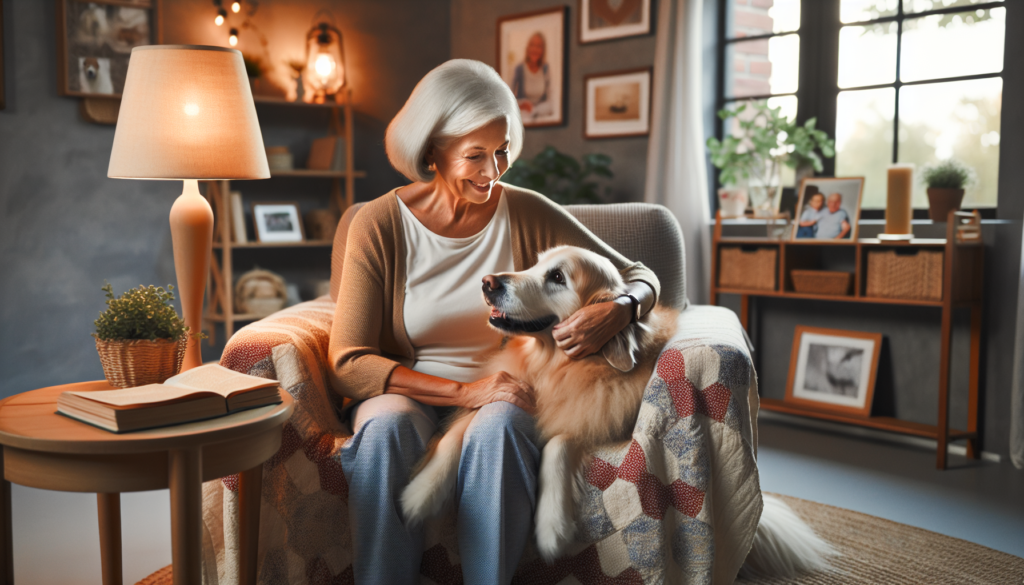Are you looking for a way to bring joy and companionship into the lives of your elderly family members? Look no further! In this article, we will explore the wonderful world of introducing pets to the elderly. Pets have been proven to provide numerous physical and mental health benefits, making them the perfect addition to any senior’s life. We will discuss the best practices for introducing pets, how to choose the right pet, and the incredible positive impact they can have on the well-being of your loved ones. So get ready to embark on an adventure that will not only brighten the days of your elderly family members, but also bring a smile to your face!

Understanding the Benefits of Pets for Elderly Family Members
Reduced stress and anxiety
Pets can have a significant impact on reducing stress and anxiety in elderly family members. The presence of a pet can provide a calming effect and help to lower blood pressure and heart rate. The simple act of petting a cat or dog can release endorphins, also known as the “feel-good” hormones, which can help to relieve stress and promote relaxation.
Increased social interaction
Pets can also increase social interaction for elderly family members. Having a pet can provide opportunities for socializing with other pet owners or neighbors while taking the pet for a walk or visiting a local park. It can also encourage conversation and interaction with family members and friends who may visit. Pets have a way of bringing people together and fostering connections, which can be especially valuable for elderly individuals who may be experiencing feelings of loneliness or isolation.
Companionship and emotional support
One of the most significant benefits of having a pet for elderly family members is the companionship and emotional support they provide. Pets offer unconditional love and affection, which can be incredibly comforting and reassuring. They become loyal companions and are always there to listen, offer comfort, and provide a sense of purpose and routine.
Improved physical health
Pets can also contribute to improved physical health in elderly family members. Taking care of a pet requires physical activity, such as walking a dog or playing with a cat. These activities can help to increase mobility and encourage regular exercise, which is essential for maintaining overall health and preventing certain medical conditions. Additionally, the presence of a pet has been linked to a decreased risk of cardiovascular diseases, such as heart attacks and strokes.
Choosing the Right Pet for Elderly Family Members
Considering lifestyle and mobility
When choosing a pet for elderly family members, it is crucial to consider their lifestyle and mobility. Some pets, such as dogs, require regular exercise and may not be suitable for individuals with limited mobility. In such cases, a more low-maintenance pet, like a cat or a small dog breed, may be a better fit. It is important to select a pet that fits well with the elderly individual’s daily routine and physical capabilities.
Matching personality traits
Matching personality traits between the elderly family member and the pet is also essential. Pets, like humans, have different personalities and temperaments. Some may be more relaxed and laid-back, while others may be highly energetic and playful. It is crucial to choose a pet with a temperament that complements the elderly individual’s personality and preferences, ensuring a harmonious relationship.
Considering allergies and sensitivities
Allergies and sensitivities are another crucial factor to consider when choosing a pet for elderly family members. Some individuals may have allergies or respiratory conditions that can be triggered by certain pets, particularly those with fur or dander. In such cases, hypoallergenic breeds or pets with minimal shedding may be more suitable. It is important to thoroughly research and consider any potential allergy or sensitivity concerns before bringing a pet into the home.
Preparing the Environment for the New Pet
Ensuring a safe living space
Before bringing a new pet into the home, it is essential to ensure that the living space is safe and suitable for the pet. This includes securing any potential hazards or dangers, such as loose wires, harmful chemicals, or breakable objects. It is important to pet-proof the house to prevent accidents and injuries.
Removing hazards and obstacles
Removing hazards and obstacles is another crucial step in preparing the environment for the new pet. Elderly family members may have limited mobility or reduced agility, so it is important to remove any tripping hazards, such as loose rugs or cluttered pathways. This will help to create a safe and accessible space for both the pet and the elderly individual.
Creating a comfortable sleeping area
Creating a comfortable sleeping area for the pet is important to ensure their overall well-being and happiness. This can be as simple as providing a cozy bed or a designated area where the pet can retreat and relax. It is important to choose a location that is quiet and away from any potential disturbances.
Arranging food and water bowls
Arranging food and water bowls in a convenient location is essential for the pet’s daily routine. It is important to consider the elderly individual’s mobility and accessibility when determining the placement of the bowls. Ensuring easy access to food and water will help to promote proper nutrition and hydration for the pet.
Educating Elderly Family Members About Pet Care
Introducing basic pet care responsibilities
Educating elderly family members about basic pet care responsibilities is crucial to ensure that they are equipped to take care of the pet’s daily needs. This includes tasks such as feeding, providing fresh water, and cleaning litter boxes or cages. Providing clear instructions and demonstrating these tasks can help to build confidence and ensure that the pet’s needs are met.
Teaching proper handling and interactions
Teaching proper handling and interactions is essential to prevent any accidental harm to the pet or the elderly individual. It is important to demonstrate gentle and respectful handling techniques, ensuring that the pet feels comfortable and secure. Elderly individuals should be educated on how to approach, hold, and interact with the pet in a safe and appropriate manner.
Explaining feeding and grooming routines
Explaining the feeding and grooming routines to elderly family members is important to ensure that the pet receives proper nutrition and care. This includes providing information on the type and amount of food to be given, as well as any dietary restrictions or special considerations. Additionally, educating the elderly individual about the pet’s grooming needs, such as brushing or bathing, can help to maintain the pet’s hygiene and overall well-being.

Gradual Introduction and Familiarization
Letting the pet explore the surroundings
During the initial stages of introducing a new pet to elderly family members, it is important to let the pet explore its new surroundings at its own pace. This can help the pet become familiar with its new environment and feel more comfortable. Elderly family members should allow the pet to explore different areas of the house, providing supervision and guidance as needed.
Encouraging supervised interactions
Supervised interactions between the pet and elderly family members are crucial to ensure the safety and well-being of both parties. By being present during these interactions, elderly individuals can establish a sense of trust and bond with the pet. Supervision also allows for immediate intervention or guidance if any behavior concerns arise.
Establishing a routine for feeding and playtime
Establishing a routine for feeding and playtime is essential for both the pet and the elderly family member. This routine helps to provide structure and predictability, which can be comforting for both parties. By having a consistent schedule for meals and playtime, the pet and elderly individual can develop a sense of familiarity and establish a strong bond.
Safety Measures During the Introduction Process
Being mindful of allergies and limitations
During the introduction process, it is crucial to be mindful of any potential allergies or limitations that either the pet or the elderly family member may have. If allergies become a concern, it may be necessary to consult with a veterinarian or consider alternative pet options. Additionally, it is important to recognize and respect any physical limitations that the elderly individual may have, ensuring a safe and comfortable experience for both the pet and the person.
Using gentle and calm approaches
Using gentle and calm approaches when introducing the pet to the elderly family member is important to create a positive experience for both. Slow and gradual introductions, accompanied by soothing tones and gentle gestures, can help to establish trust and reduce any potential anxiety or fear. Patience and understanding are key during this process.
Supervising interactions between pets and elderly family members
Supervising interactions between pets and elderly family members is crucial to ensure the safety and well-being of both parties. Elderly individuals may not have the same level of physical strength or agility as younger individuals, so it is important to closely monitor their interactions to prevent any accidental injuries or falls. This supervision also allows for immediate intervention if any behavior concerns arise.
Building Trust and Bonding Between Pets and Elderly Family Members
Encouraging positive associations and rewards
Encouraging positive associations and rewards is key to building trust and bonding between pets and elderly family members. This can be done through gentle praise, treats, and affection when the pet displays desirable behaviors or responds positively to interactions. Positive reinforcement helps to strengthen the bond and create a happy and trusting relationship.
Spending quality time together
Spending quality time together is essential for building trust and strengthening the bond between pets and elderly family members. This can involve activities such as grooming, playing, or simply sitting together and enjoying each other’s company. Regular, dedicated time for one-on-one interaction allows the pet and elderly individual to establish a deeper connection.
Engaging in activities that promote bonding
Engaging in activities that promote bonding is an excellent way to strengthen the relationship between pets and elderly family members. This can include going for walks together, participating in gentle exercise routines, or even attending pet-friendly events or gatherings. Shared experiences and activities help to create lasting memories and enhance the bond.
Addressing Challenges and Concerns
Recognizing signs of stress or discomfort
It is important to be vigilant and recognize signs of stress or discomfort in both the pet and the elderly family member. These signs may include changes in behavior, increased vocalization, loss of appetite, or withdrawal. By being aware of these signs and addressing them promptly, it is possible to mitigate or resolve any challenges or concerns that may arise.
Consulting with a veterinarian or animal behaviorist
If any challenges or concerns persist, it is advisable to consult with a veterinarian or animal behaviorist. These professionals can provide expert guidance and advice on how to address specific issues and ensure the well-being of both the pet and the elderly family member. They may suggest behavior modification techniques, training methods, or recommend additional resources and support.
Addressing compatibility issues if they arise
In some cases, compatibility issues may arise between the pet and the elderly family member. This can be due to personality clashes, allergies, or other unforeseen circumstances. If compatibility becomes a significant concern, it is important to address the issue promptly and explore alternative solutions, such as rehoming the pet or considering a different pet that may be more suitable for the individual’s needs.
Promoting a Healthy Lifestyle for Pets and Elderly Family Members
Encouraging regular exercise and playtime
Encouraging regular exercise and playtime is essential for promoting a healthy lifestyle for both pets and elderly family members. Daily exercise helps to maintain mobility, prevent weight gain, and promote overall well-being. Engaging in interactive play sessions, such as tossing a ball or playing with toys, can also provide mental stimulation and promote a sense of joy and happiness.
Monitoring and maintaining proper nutrition
Monitoring and maintaining proper nutrition is crucial for the health and well-being of both pets and elderly family members. This includes providing balanced and age-appropriate meals for the pet and ensuring that the elderly individual’s dietary needs are also met. Regularly monitoring food intake and making necessary adjustments can help to prevent obesity and keep both the pet and the person in optimal health.
Ensuring regular veterinary check-ups
Regular veterinary check-ups are essential for both pets and elderly family members. These check-ups help to detect any potential health issues early on and ensure that appropriate interventions or treatments are put in place. Routine vaccinations, dental care, and general health examinations are all important aspects of maintaining the well-being of both pets and elderly individuals.
Continued Support and Assistance
Offering assistance with pet care tasks
Offering assistance with pet care tasks is important to ensure that the elderly family member does not become overwhelmed or feel burdened by the responsibilities. This can include tasks such as feeding, grooming, or cleaning up after the pet. By providing support and assistance when needed, the elderly individual can continue to enjoy the companionship of the pet without feeling overwhelmed.
Providing resources and information
Providing resources and information is crucial to empower the elderly family member to continue providing proper care for the pet. This can include educational materials, such as books or brochures, that offer guidance on pet care best practices. It is also helpful to keep the elderly individual informed about any new information or resources that may be relevant to their pet’s health and well-being.
Seeking additional help and support if needed
If the elderly family member requires additional help or support in caring for the pet, it is important to explore available options. This can include enlisting the help of family members, neighbors, or friends who may be willing to assist with pet care tasks. Alternatively, there may be local pet care services or organizations that can provide support, such as dog walking services or pet sitting services.
In conclusion, introducing a pet to an elderly family member can have numerous benefits and enhance their overall well-being. By understanding the benefits of pets for elderly individuals and taking the necessary steps to ensure a safe and positive introduction process, pets can become valuable companions and provide a source of joy, comfort, and support. With proper education, preparation, and ongoing support, pets can bring immense happiness and improve the quality of life for elderly family members.

